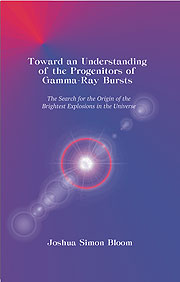
Toward an Understanding of the Progenitors of Gamma-Ray Bursts
by Joshua S. Bloom

 View First 25 Pages:
View First 25 Pages:
 (free download)
(free download) Synopsis
The various possibilities for the origin ("progenitors") of gamma-ray bursts (GRBs) manifest in differing observable properties. Through deep spectroscopic and high-resolution imaging observations of some GRB hosts, I demonstrate that well-localized long-duration GRBs are connected with otherwise normal star-forming galaxies at moderate redshifts of order unity. Using high-mass binary stellar population synthesis models, I quantify the expected spatial extent around galaxies of coalescing neutron stars, one of the leading contenders for GRB progenitors. I then test this scenario by examining the offset distribution of GRBs about their apparent hosts making extensive use of ground-based optical data from Keck and Palomar and space-based imaging from the Hubble Space Telescope. The offset distribution appears to be inconsistent with the coalescing neutron star binary hypothesis (and, similarly, black-hole--neutron star coalescences); instead, the distribution is statistically consistent with a population of progenitors that closely traces the ultra-violet light of galaxies. This is naturally explained by bursts which originate from the collapse of massive stars ("collapsars"). This claim is further supported by the unambiguous detections of intermediate-time (approximately three weeks after the bursts) emission "bumps" which appear substantially more red than the afterglows themselves. I claim that these bumps could originate from supernovae that occur at approximately the same time as the associated GRB; if true, GRB 980326 and GRB 011121 provide strong observational evidence connecting cosmological GRBs to high-redshift supernovae and implicate massive stars as the progenitors of at least some long-duration GRBs. Regardless of the true physical origin of these bumps, it appears that all viable alternative models of these bumps (such as dust scattering of the afterglow light) require a substantial amount of circumburst matter that is distributed as a wind-stratified medium; this too, implicates massive stars. Also suggested herein are some future observations which could further solidify or refute the supernova claim. In addition to the observational and modeling work, I also constructed the Jacobs Camera (JCAM), a dual-beam optical camera for the Palomar 200--inch Telescope designed to follow-up rapid GRB localizations.
About the Author
Joshua Simon Bloom attended Harvard College
(1992-1996) for his undergraduate degree in Physics and
Astrophysics. On a Herschel Smith Harvard Fellowship, he then obtained
a Masters of Philosophy degree at Cambridge University (1997) under
the tutelage of Professor Martin Rees. With Professor Shrinivas
R. Kulkarni as adviser, the author obtained a Ph.D. in Astrophysics at
the California Institute of Technology (Caltech) in Pasadena (2002),
where he was a Fannie and John Hertz Foundation Scholar. The author
is currently a Junior Fellow to the Harvard Society of Fellows. He
resides in Cambridge, Massachusetts.

